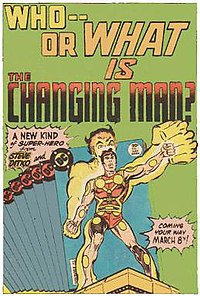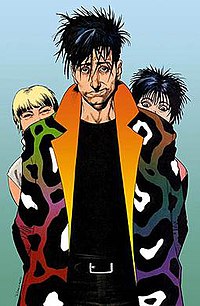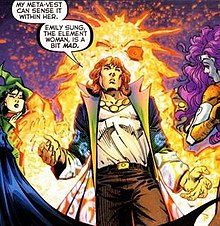Loading AI tools
Fictional comic book character created by Steve Ditko for DC Comics in 1977 From Wikipedia, the free encyclopedia
Shade, the Changing Man is a comic book character created by Steve Ditko for DC Comics in 1977.[1] The character was later adapted by Peter Milligan and Chris Bachalo in one of the first Vertigo titles.
| Shade, the Changing Man | |
|---|---|
 The original Shade version by Steve Ditko. | |
| Publication information | |
| Publisher | DC Comics |
| First appearance | Shade the Changing Man #1 (June 1977) |
| Created by | Steve Ditko |
| In-story information | |
| Alter ego | Rac Shade |
| Team affiliations | Suicide Squad Justice League Dark Justice League Multiverse Justice League |
| Notable aliases | Mad Mod Poet God |
| Abilities | The M-Vest creates a strong forcefield that repels weaponry, allows a degree of flight and distorts Shade's appearance dependent on the viewer's mental state or his own. |
Both versions of Shade are distinct from the Shade, another DC Comics character.
Shade, the Changing Man told the story of a fugitive from the militant planet Meta in another dimension. Shade (whose full name is Rac Shade) was powered by a stolen "M-vest" (or Miraco-Vest, named for its inventor) which protected him with a force field and enabled him to project the illusion of becoming a large grotesque version of himself.[2]
The character was the first Ditko had created, or helped to create, for a mainstream publisher for many years. Prior to rejoining DC Comics, Ditko had worked on characters such as his Mr. A. title. Shade was very much a return to mainstream superheroics, although Shade indicated no particular connection with the DC Universe (although the letters columns stated that there is no reason it could not be shown to be there). Michael Fleisher scripted the series based on Ditko's plotting and art.
His series ran for eight bi-monthly issues in 1978 before its sudden cancellation in the wake of the "DC Implosion", a contraction of DC's line that saw a third of their books axed right before the September releases. A ninth extra-length issue, featuring the debut of a new Ditko character called the Odd Man, was produced, but was published only as a part of DC's Cancelled Comic Cavalcade in 1978. A revised version of the Odd Man story appeared in Detective Comics #487 (Dec. 1979-Jan. 1980). Both stories were published in The Steve Ditko Omnibus Vol. 1 (2011),[3] a hardcover collection of Ditko's DC work.
After this, Shade was adopted into the DC Universe and made a brief appearance in the Crisis on Infinite Earths miniseries as well as becoming a regular character in Suicide Squad.

Rac Shade is a secret agent from the Meta-Zone dimension who was framed for treason and sentenced to death. Through various events, Shade spent some time on Earth trying to clear his names, but was met with resistance of the Meta-authorities at each point. His name was being cleared, but he remained a wanted man, and Shade continued to use the M-Vest. Shade's former fiancée Mellu Loron wanted to kill him for some time for causing an explosion that crippled her parents. Her mother, operating a mechanical monster called the Supreme Decider (or Sude) had other plans.
The Metans have an outpost on Earth which is called the Occult Research Center (O.R.C). The center was run by Wizor, assisted by Leno. Mellu ran it for a time. The O.R.C. operates by telling the absolute truth about Meta, something the public tends to laugh off. When Mellu desires to kill Shade, the fact that other, more violent, criminals released in the freak accident during the prison riot that freed Shade become priority, annoys her greatly and causes her to leave the organization.
When Dr. Sagan shows Mellu videotape evidence that Shade has rescued her from a deadly part of the Zero-Zone called the Area of Madness (from which no one but Shade, thanks to the vest, has exited without expending all their bodily resources screaming), she changes her mind about Shade, in spite of having been the one who had ultimately captured him.
In the final issue, President Olon's hands are tied in regard to the treason charge. Even though he considers Shade innocent, until his death sentence is overturned in court, he is still under a death sentence as Col. Kross gathers evidence in his defense. With all of these on his side, he (Shade) leaps into the Zero-Zone and is swallowed by the Area of Madness.
Shade later joins the Suicide Squad, but has second thoughts, leading Lashina to manipulate him into helping her under the pretense of returning him to the Meta-Zone.[4] However, she betrays him and several of his friends are killed by Parademons and the Female Furies. Darkseid appears and settles the conflict, returning Shade home.[5]
| Shade, the Changing Man | |
|---|---|
 The third iteration of Milligan's Shade (center), with Kathy (left) and Lenny, taken from Shade the Changing Man #50; art by Brian Bolland. | |
| Publication information | |
| Publisher | DC Comics, Vertigo |
| First appearance | Shade the Changing Man #1 (July 1990) |
| Created by | Peter Milligan and Chris Bachalo |
| In-story information | |
| Alter ego | Rac Shade |
| Notable aliases | Troy Grenzer |
| Abilities | Can use his Madness Vest to warp reality to his will |
In July 1990, six months after Shade's final appearance in Suicide Squad, Shade was revamped by Peter Milligan and Chris Bachalo, becoming part of the so-called "British Invasion", alongside Neil Gaiman's Sandman and Grant Morrison's Animal Man.
The new series still took place in the DC Universe: John Constantine turned up for a three-issue story arc, Death of the Endless appeared in a subtle cameo in issue #50 and Shade appeared with a group of other Vertigo characters in 1999's one-shot Totems. The comic departed quickly from its origins. Milligan and Bachalo reinvented Rac Shade as a red-headed lovelorn poet sent to Earth to stop a growing tide of madness from consuming the planet, his M-Vest becoming a Madness-Vest capable of warping reality. Working from Brendan McCarthy's character designs, Bachalo created a distinctive look for the comic, distinguishing it from the character's other DC Universe appearances. The original series was retconned as a story that Shade made up to amuse himself while traveling to Earth (left unexplained was his stint with the Suicide Squad).
Milligan killed Shade off several times during the series, bringing him back each time in a different form: a woman; a black-haired madman; a red-haired, emotionless mod; and a bedraggled, unshaven obsessive.
The series employed concepts and ideas which were at times controversial and distinct from regular DC titles (for example, JFK's assassination and transgenderism). To distinguish these more 'adult' themes in Shade and other titles, DC created the Vertigo imprint in 1993. Shade became one of the initial Vertigo titles starting with issue #33.
Shade sold steadily for Vertigo and maintained a cult following. The title lasted 70 issues before being cancelled in 1996.
In 2003, a special one-off story by Peter Milligan and artist Mike Allred was printed as part of Vertigo's 10th anniversary celebration.
In 2004, the first six issues of Shade were reprinted as a Vertigo trade paperback.
In August 2010, Hellblazer #268 featured the return of Shade, the Changing Man, this time as a supporting cast member for John Constantine in a series of storylines written by Milligan.
According to the Absolute Crisis on Infinite Earths hardcover book, the events of the second series originally took place on Earth-85 in the DC Multiverse before its destruction.
In 2011, Shade was featured in Geoff Johns' Flashpoint miniseries and its spin-off miniseries Flashpoint: Secret Seven (written by Peter Milligan) as the leader of the Secret Seven.[6] After Flashpoint as part of The New 52 (a reboot of the DC Comics universe), Shade appears as one of the lead characters in the first story arc of Justice League Dark, a new title written by Peter Milligan[7] and drawn by Mikel Janin.

The original Steve Ditko series is collected in The Steve Ditko Omnibus Vol. 1 (2011).[3]
The Vertigo series is being collected into trade paperbacks:
The Young Animal series is collected into three trade paperbacks:
Seamless Wikipedia browsing. On steroids.
Every time you click a link to Wikipedia, Wiktionary or Wikiquote in your browser's search results, it will show the modern Wikiwand interface.
Wikiwand extension is a five stars, simple, with minimum permission required to keep your browsing private, safe and transparent.